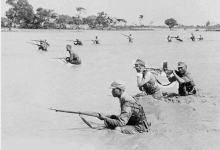Flooding of the Yellow River in 1938
The Yellow River was deliberately flooded from June 9, 1938 in connection with the Second Sino-Japanese War .
A dam on the Yellow River was blown up on the orders of General Chiang Kai-shek near Huayuankou , Henan Province , to cause widespread flooding; The reason for this was to prevent the rapid advance of Japanese troops.
Strategic decision to flood
The Second Sino-Japanese War, raging since July 7, 1937, led to a rapid Japanese occupation of large areas of China. Just one year after the war began, the Japanese had occupied large areas in northern China and conquered Kaifeng , the capital of Henan Province . Zhengzhou , an important rail hub on the Beijing – Guangzhou and Longhai routes , was in danger of being captured by the Japanese, which would have threatened the cities of Wuhan and Xi'an . Instead of using the scorched earth strategy , the High Command of the National Revolutionary Army decided , in a desperate action, to flood the land ahead of the anticipated Japanese advance. To this end, the quintessential Chinese civilization, the Yellow River , should be turned into a weapon against the aggressors. The southern section of the river was breached at Huayuankou in Henan, 30 km from the top of the Japanese troops.
Opening the dam turned out to be more difficult than expected: Between June 4 and 6, National Revolutionary soldiers made two unsuccessful attempts to blow up the dam at Zhaokou. A second attempt was made on June 9 at Huayuankou by removing parts of the dam. The pressure of the river eventually opened the weakened point on the dam and the water poured into the plain. In the days that followed, the opening increased steadily. Only residents living in the immediate vicinity of the breach of the dam were warned of the disaster.
consequences
It was the largest man-made flood disaster and the largest environmental disaster in a military context in the world. Over 893,000 people died, 4,000 villages and 11 cities were destroyed. About 3.9 million people became homeless refugees (20% of the population in Henan , Anhui and Jiangsu ). The course of the river was influenced by the flooding over a length of approx. 1,000 kilometers, for the most part the water has taken a completely different, original route. The flood ended in 1947.
literature
- Kathryn Edgerton-Tarpley: From 'Nourish the People' to 'Sacrifice for the Nation': Changing Responses to Disaster in Late Imperial and Modern China. The Journal of Asian Studies 73/2 (2014), pp. 447-469.
- Diana Lary: Drowned Earth: The Strategic Breaching of the Yellow River Dyke, 1938. War in History 8/2 (April 2001), pp. 191-207.
- Diana Lary: The Waters Covered the Earth: China's War-Induced Natural Disasters. In: Mark Selden, Alvin So (Eds.): War and State Terrorism: The United States, Japan, and the Asia-Pacific in the Long Twentieth Century. Rowan and Littlefield, Lanham (Maryland) / Oxford, 2004, ISBN 0-7425-2390-X and ISBN 0-7425-2391-8
- Micah S. Muscolino: The Ecology of War in China: Henan Province, the Yellow River, and Beyond, 1938–1950 (= Studies in environment and history). Cambridge University Press, New York, 2015, ISBN 978-1-107-07156-8 and ISBN 978-1-107-41759-5
Web links
- Yellow River flood, 1938-47. DisasterHistory.org, accessed January 7, 2017 .
- Diana Lary: Drowned Earth: The Strategic Breaching of the Yellow River Dyke, 1938. SAGE Journals, accessed January 7, 2017 .
- Floods In China (1938). YouTube, accessed January 7, 2017 .
- 1938, Yellow River flood by Sino-German Cooperation until 1941. YouTube, accessed on January 7, 2017 .
Individual evidence
- ↑ Micah S. Muscolino, The Ecology of War in China: Henan Province, the Yellow River, and Beyond , Cambridge and New York: Cambridge University Press, 2015.
- ↑ Diana Lary: Drowned Earth: The Strategic Breaching of the Yellow River Dyke, 1938. SAGE Journals, April 1, 2001, accessed January 7, 2017 .
- ↑ a b c Yellow River flood, 1938-47. DisasterHistory.org, accessed January 7, 2017 .
- ↑ http://www.earthmagazine.org/article/june-9-1938-huang-he-diversion-largest-act-environmental-warfare-history
- ↑ a b Han Qitong, Nan Zhongwan: Huangfanqu de sunhai yu shanhoujiuji . Pp. 22-23.

